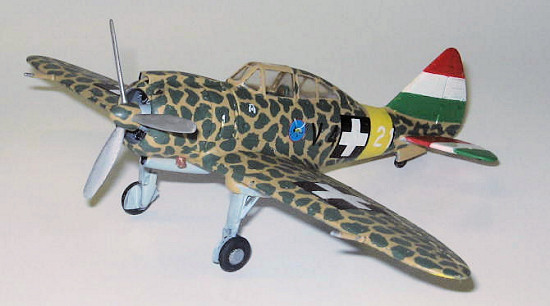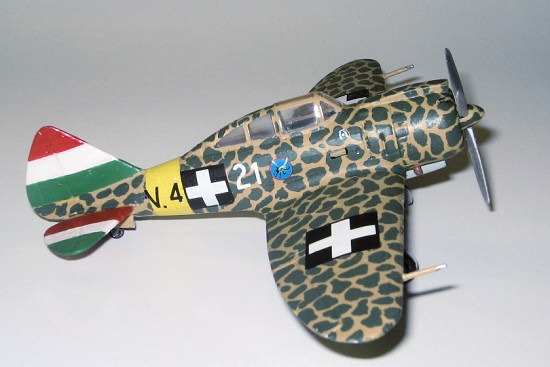
Supermodel 1/72 Re.2000 'Falco'

| HISTORY |
The Reggiane Re-2000 was designed by a design bureau led by Engineer Longhi. Longhi worked at Uppercu Burnelli Aircraft Corporation, a subsidiary of Uppercu Cadillac Corporation. That is where he got acquainted with the Seversky P-35, upon which he modelled his new design.
 The prototype first took
to the air in May 1939. Although the aircraft was an advanced design, it was
rejected by the Italian authorities. The main objection was that the wing fuel
tanks were unprotected.
The prototype first took
to the air in May 1939. Although the aircraft was an advanced design, it was
rejected by the Italian authorities. The main objection was that the wing fuel
tanks were unprotected.
Technical data:
Wingspan: 11 m; Length: 7,99 m;, Height: 3,20 m; Max. speed: 530 km/h; Armament: 2 db 12,7 mm guns in the cowling, later 2 more in the wings; Power plant: Piaggio P-XI RC 40, 1000 HP
Major versions:
I (=Intercettore), Cat (=Catapultabile, on board ships) , GA (=Grande Autonomie) long range, BIS: equipped with the Piaggio P. IX Bis motor
The original of our kit was the personal mount of Istvan Horthy, Deputy Governor of Hungary, the son or Regent Miklos Horthy. Regent Horthy sent his elder son to the front to indicate that his own family was not exempted from the war efforts of the nation. It was in V.4+21 that Horthy crashed and died at 05:07 a. m. on the 20th of August 1942. His death launched a series of gossips and wild rumours, including conspiration theories suggesting that Horthy's plane was sabotaged by the German secret service. The reason was supposed to be the worry of the Germans that the popular Deputy Governor, who had studied in the U. S. and who had good connections with American and English politicians, was going to get Hungary, ”the reluctant ally,” out of the war.
 The 20th of August is the
national holiday of Hungary, and it is unlikely that the Abwehr chose such a
conspicuous date for the murder. It was also suggested that Horthy was
inexperienced with the Reggiane, as he had only flown a total of 75 hours in the
type. His general skills as an aviator were not questioned, as he had flown from
Budapest to Bombay and back in an Arado sports plane before the war. He also
appeared to have some experience with the Italian fighter, as earlier in August
he shot down a Yak, and on another occassion he returned to his airfield with
eight bullet holes in his Reggiane. It is a more likely explanation that one of
the frequent malfunctions of the Piaggio engine occured, and the altitude of
about 300 m was not sufficient for the pilot to carry out some maneouvre in
order to counter the effect of the sudden loss of engine performance. Horthy's
widow, Countess Edelsheim-Gyulai now lives in Australia with her second husband.
The 20th of August is the
national holiday of Hungary, and it is unlikely that the Abwehr chose such a
conspicuous date for the murder. It was also suggested that Horthy was
inexperienced with the Reggiane, as he had only flown a total of 75 hours in the
type. His general skills as an aviator were not questioned, as he had flown from
Budapest to Bombay and back in an Arado sports plane before the war. He also
appeared to have some experience with the Italian fighter, as earlier in August
he shot down a Yak, and on another occassion he returned to his airfield with
eight bullet holes in his Reggiane. It is a more likely explanation that one of
the frequent malfunctions of the Piaggio engine occured, and the altitude of
about 300 m was not sufficient for the pilot to carry out some maneouvre in
order to counter the effect of the sudden loss of engine performance. Horthy's
widow, Countess Edelsheim-Gyulai now lives in Australia with her second husband.
| THE KIT |
Supermodel's kit is
not a new one. The panel lines are raised, and we get nothing in terms of cabin
interior. Apart from that, the kit builds into a nice model, with not too many
problems during the construction. A small amount of filler was needed at the
wing
 roots,
and there was only a minimum amount of flash on the propeller blades.
roots,
and there was only a minimum amount of flash on the propeller blades.
The box contained two canopies: the first version, with glazed rear sections and without an aerial mast, and the later version, with armoured rear sections and with an antenna mast. In fact, Horthy's plane, although it was the earlier version of the Reggiane, did have an antenna mast, which was not common with the earlier version (and I did not add the mast to the finished model).
As the canopy was nice and clear (despite the long years it floated in the box), I produced a symbolic instrument panel and added a short piece of stretched sprue for something that remotely resembled a control column. The few photos of the plane I was able to find show that there was some structure in the rear part of the cockpit supporting the head armour of the pilot, but as my sources only show it from the side, with no real detail visible, I did not put there anything. The cushion behind the pilot's head was painted reddish brown, and the cockpit was considered ready in its grossly simplified form.
| CONSTRUCTION |
The parts of the landing gear showed the age of kit, but assembly was straightforward and problem-free. The wheel discs and the tyres are supplied as separate parts, which makes painting a lot easier.
 The engine cowling
did not come in one tube-like piece as it usually comes in the case of kits of
radial-engined planes from FW-190 to the Zero or the F4F, but in two shells to
be glued together to form the tube that contains the engine. Fit was good, but
if it had not been so, the two air intakes on the top and the bottom of the
engine would have concealed any shortcomings. Then followed a rim for the front
of the engine cowling. The places of the two guns were only marked on the inner
side of the rim, so the holes had to be drilled through. The holes of the wing
guns were ready, although it would have been more logical to leave the drilling
of the holes of the wing guns to the modeller, and punch the holes in the engine
rim at the factory, because wing armament was normally used in the later version
of the plane only, whereas the guns above the engine were standard on all
versions.
The engine cowling
did not come in one tube-like piece as it usually comes in the case of kits of
radial-engined planes from FW-190 to the Zero or the F4F, but in two shells to
be glued together to form the tube that contains the engine. Fit was good, but
if it had not been so, the two air intakes on the top and the bottom of the
engine would have concealed any shortcomings. Then followed a rim for the front
of the engine cowling. The places of the two guns were only marked on the inner
side of the rim, so the holes had to be drilled through. The holes of the wing
guns were ready, although it would have been more logical to leave the drilling
of the holes of the wing guns to the modeller, and punch the holes in the engine
rim at the factory, because wing armament was normally used in the later version
of the plane only, whereas the guns above the engine were standard on all
versions.
The double radial engine is nicely detailed, and for a while I was thinking of finding a way of making it visible, but I did not find sources to illustrate how the various panels opened to give access to the engine, so I finally finished the engine section in a fully enclosed position.
| COLORS & MARKINGS |
 For painting, mostly
Humbrol enamel paints were used, although the red of the national markings is
Revell gloss enamel. When all the paints were dry, a coat of gloss Revell
varnish was applied, to place the decals on.
For painting, mostly
Humbrol enamel paints were used, although the red of the national markings is
Revell gloss enamel. When all the paints were dry, a coat of gloss Revell
varnish was applied, to place the decals on.
Three decal versions are supplied with the kit: one Swedish, one Italian (Navy) and one Hungarian, with the old wedge-type markings, standard before 1942. As I wanted to make Horthy's plane, I did not use the kit's sheet. The decals produced for Horthy's plane are, however, not all accurate. Even Toff's new sheet (www.toff.hu) contains black numbers for the yellow fuselage band. Original photographs clearly show that number 21 was white, with 1 slightly behind, and not right on, the yellow band. In order to make it clearly visible, the white 1 behind the yellow band had a black edge. I used the old H.A.D. decal sheet ( www.had.hu ) that contains both white and black numerals, and used the back 1 to provide the edge of the white numeral. When all decals were in place, two layers of Humbrol satin varnish were added to seal them.
| CONCLUSIONS |
The Czech Special Hobby now produces a Reggiane kit in 1:72, with more detail, recessed panel lines, and apparently accurate markings for Horthy's aircraft.
June 2006
Copyright ModelingMadness.com. All rights reserved. No reproduction in part or in whole without express permission from the editor.
If you would like your product reviewed fairly and fairly quickly, please contact the editor or see other details in the Note to Contributors.